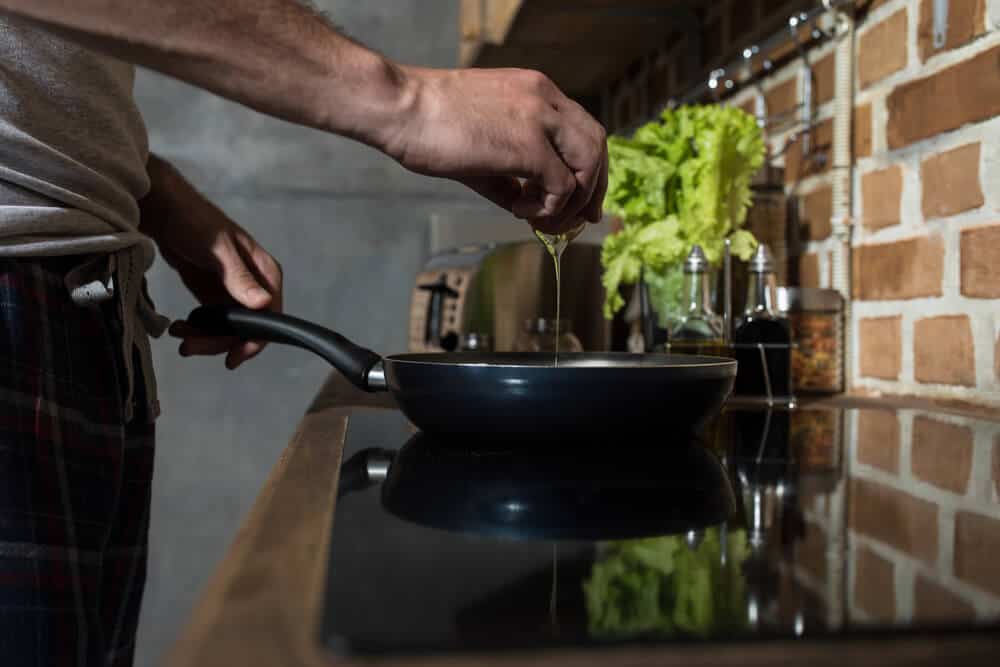We’ve been researching the best induction cooktops Australia has to offer for the last few months and finally we’ve settled on our best five.
The market is crowded and it look some time to find the ones consumers actually want. However we believe you can’t go wrong with these selections.
Over 40 hours of research went into choosing these products, hours of comparing features and ultimately writing about the very best Aussies actually want to buy.
You can buy cheap induction cooktops from places such as BigW, Kmart, Bing Lee and Target, but we’ve opted to focus on brand names that are known for their high quality and extended warranties.
Best Induction Cooktops Australia
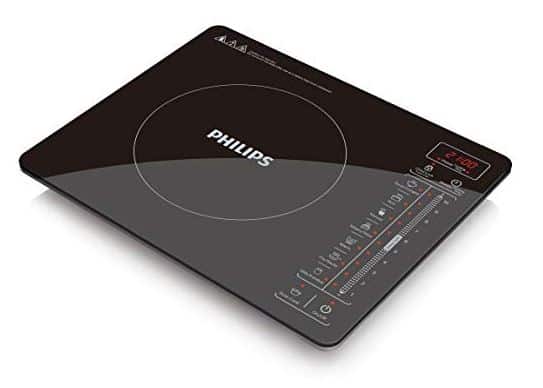
The Premium Collection Ultra-Thin induction cooktop from Philips is a stylish and highly efficient unit ideal for use either in your kitchen or caravan.
Induction cooking is a relatively new way of cooking and does require some adjustment when you’re used to gas or electric stovetops, but it’s well worth the change. The cooktop comes with a User Manual to help you learn how to use induction cooking if you are new to it, and how to make the best use of the appliance.
This induction cooktop uses an industry-leading high-efficiency copper magnetic coil to convert 2100W of electrical currents into up to 280 degrees of instant heat in your pots and pans. Similar technology is found in stand mixers and food processors.
The ultra-thin flat panel design encases a fan duct layout, a high-frequency rotation fan, a spaced heating coil, insulation technology and a high-efficiency cooling system. And there are nine inbuilt self-protective and diagnostic functions. All working to ensure maximum safety and to extend the product’s life.
There are 10 temperature settings to suit all your cooking requirements from quick frying to slow cooking. You can use the timer to preset a start time (up to 24 hours) or stop time (up to 10 hours).
The top ceramic plate is sleek and easy to clean. The controls are sensor touch buttons for a modern feel and a long life.
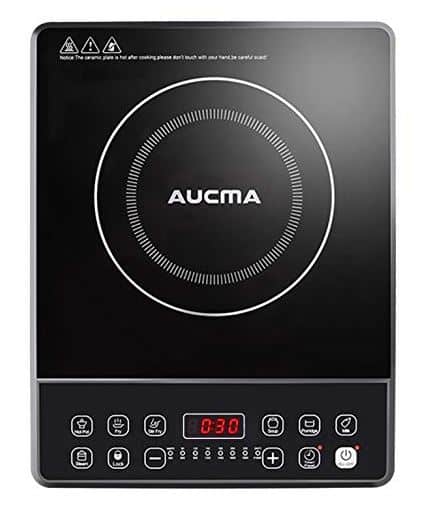
The AUCMA Portable Induction Cooktop is a great idea for the caravan or RV, or even as an addition to your small kitchen if you’re looking to save space and power costs. Simply plug in and use – no expensive installation costs.
Induction cooking is coming into its own and definitely worth a try, especially at this price point. No wasted energy and instant heat and cool. You have absolute and instantaneous control over the temperature.
The AUCMA induction cooktop has a double coil design, which produces a faster and more uniform heat. Its 7 cooking modes allow for temperature ranges between 60-200 degrees Celsius so you can slow simmer or quick fry.
It has a timer function. And safety features such as auto shut down when the internal temperature is higher than 160C.
You may have heard that induction cooking requires special pots and pans. That’s true but the AUCMA will work with stainless steel, cast iron, steel/enamel kettles, iron/steel frypans, and even enamel-ware.
So it may not be quite as restrictive as you imagine. Test your current pots with a magnet to check before you go out and buy new cookware.
This cooktop looks great and has an easy to clean and waterproof ceramic glass plate with touch sensor controls. It’s durable as well. And it’s a compact 36x28x4.5cms – small enough to fit easily into a caravan or a kitchen bench. The base has skid-proof rubber pads so the unit won’t slide over your benchtop while you’re cooking.
Remember: always read the manufacturer’s instructions, especially if you’re new to induction cooking. It is different!
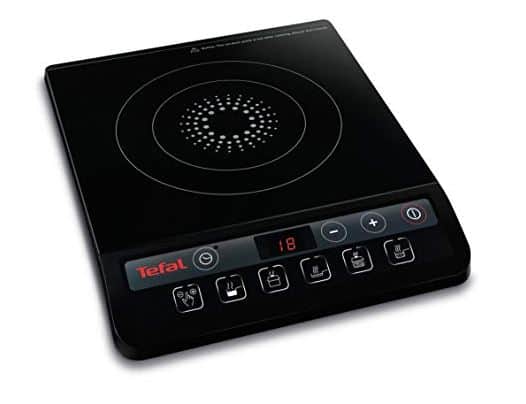
The Induction Hob (IH2018) from TEFAL is a high-quality portable cooktop using the relatively new induction cooking technique.
This is a versatile and multi-functional appliance for people on the go who want fast and simple cooking when they’re wanting to use their time enjoying faraway sights and adventures. If that describes you, and as long you have access to a power plug, this is the cooktop for you.
Cooking with induction heating is very different from gas or traditional electricity. Without getting too technical, the main difference is that the heat is instantaneous and you have absolute and immediate control over it.
There is no (or very little) leakage of heat to the surrounding cooking plate or air. Once you’re accustomed to that it’s fantastic for speed.
And it’s very safe as well. The one issue with induction cooktops is that the cookware does need to have ferrous bases, ie magnetic.
So you’ll need to test your pots with a magnet to see whether they’ll be suitable for use on the TEFAL hob. If not you will need to purchase a new pot or two.
The TEFAL portable induction cooktop is a slim-line ceramic hob with six cooking functions: manual, hot milk, soup, stew, stir fry and fry.
It has nine power levels from 450-2100W and a 2-hour timer. The hob will accommodate a pot or pan with a diameter between 12cm and 26cm. It has a LED digital display.
The sleek black ceramic plate is scratch proof, heat-proof, easy to clean and durable.
The cooktop comes with a User’s Manual to help you learn how to use it.

The Philips Viva Collection Induction Cooker has been designed with convenience firmly in mind. Whether you like to travel around in a camper van or RV, or just have an easy to clean quick cooker at hand in the kitchen this may suit you to a tee.
If nothing else induction cooking is quick and efficient. It gives you total and instant control over the heat it produces, and this cooktop reaches temperatures as high as 280 degrees Celsius in a second.
Although it uses electricity, so you do need a power point to plug it in to, the heating element is a copper coil underneath the cooktop which heats only the pot on top of it, not the cooktop itself.
What this means is that you don’t have radiant heat escaping into the rest of the plate or the surrounding air. It’s safe (no naked flames and no hot surfaces to burn your hand on).
It’s relatively inexpensive – induction cooking uses 95% of the power it consumes. And it’s very safe with auto shut off features and internal fans to prevent overheating.
The Philips Viva is very user-friendly: it has a 24 hour pre-set function, and 1-120-minute cook time settings to suit most recipes as well as a 600 minute setting for slow cooking.
The fast cooking options are great for retaining nutrients in your foods.
The cooktop features an easy to read digital display and a full glass top which cleans in a jiffy. Its touch sensor interface is a breeze to use, and keeps the unit clean and looking like new as well.
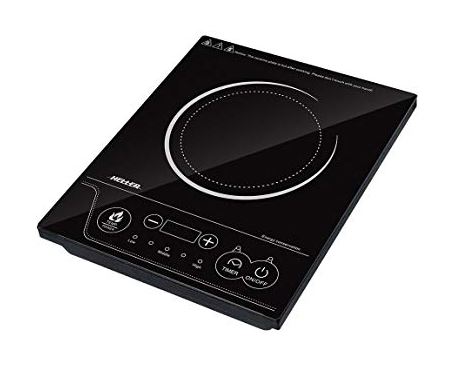
The Heller Portable Induction Cooker has been designed, and is ideal, for cooking in the great outdoors – but note that there does need to be an electrical power source in that part of the outdoors you happen to be in because induction cooktops are powered by electricity.
Now the small portable ones require a pretty small voltage (15amps or so) but you still need to consider this. Some research may be appropriate.
If you haven’t experienced induction cooking you’ll be amazed at the difference between it and other forms of cooking food.
The induction cooktop uses a copper coil underneath the ceramic top to create an electro-magnetic field in the cooking pot, which then creates heat through ‘induction’.
The heat is instant and can be minutely controlled, unlike gas and, particularly, electric cooktops. And the temperatures are much greater because the heat does not ‘leak’ into the surrounding surface or air.
What all that means is that there are a few things to get used to when you’re using an induction cooktop for the first time. Reading the instruction or User’s Manual is recommended.
The other difference with induction cooking is that they require a certain type of cookware – they must have a ferrous base.
The best way to find out whether your current pots and pans will suit is to see whether a magnet sticks to the base of them. If not then you would need to purchase at least one ferrous-based pot.
The Heller Portable Induction Cooktop is a small appliance – only 30x38x9cms – so it will easily fit into a caravan or RV or a car boot.
Because it’s an induction cooktop with a strong 2,000W heating element it’s brilliant for quick meals on the go. But it’s versatile – it has five adjustable heat settings so you can do anything from a quick stir fry to a slow braise. There’s a 2-hour timer to help you relax while the meal’s cooking.
It’s a very nice looking unit with a strong black crystal glass plate and digital LED display lights. The control panel is an easy to use sensor touch type. The cooking area is a diameter of 15.8cms.
All in all, this is a very nice portable cooktop at a great price.
Do portable induction cooktops work?
There’s no question that induction cooking is fast growing in popularity. Ignoring the question of portability for the moment, let’s first look at whether induction cooking is any good.
Firstly, don’t confuse induction cooktops with smooth-top electric cookers, which have burners underneath.
Induction cooking does not use burners – it uses a current passing through a copper wire coil underneath the cooking pot to ‘induce’ an electrical current in the pot itself.
The resulting resistance within the metal of the pot creates heat. In its simplest form, the pot needs to be made from a strong metal such as iron or steel, but developments in the design of induction cooktops have meant that a larger range of metal pots can be used, as long as they have a ferrous base.
Induction cooking is very efficient – it does not create heat to escape into the surrounding air. It heats up and cools down very quickly.
It therefore has safety advantages. Because it doesn’t heat the cooktop itself it is very easy to clean as well.
Because induction cooktops use such a high wattage of electric current they may be a little more expensive than gas. But it is also a very fast way to cook.
In other respects, there are no real doubts about induction cooking in relation to health and safety. Food tastes exactly the same.
Now turning to the portability question. Bearing in mind all the pros and cons of induction cooking generally, the question is whether you can use a portable induction cooktop (there are plenty on the market) with solar power panels or a generator when camping.
And the answer is a resounding yes, as long as you have an adaptor to plug the cooktop in. Indeed many travel/camping websites are recommending portable induction cookers as the way to go.
How to use an induction cooktop?
As with any new appliance it serves you well to read the manufacturer’s operating instructions before you use the induction cooktop for the first time. And then to experiment with it to build your confidence and repertoire.
The first step is to test all your cookware to make sure that it’s suitable for induction cooking. Basically, it needs to be ferrous – or magnetic.
The easiest way to test it is to use a magnet on the base. If the magnet is attracted to the base of the pot then that pot is fine to use on the induction cooker.
Then familiarise yourself with the mechanics of induction cooking. The cooktop itself will never get hot. It’s completely safe to touch. It’s the reaction between the coil underneath the top and the pot that heats and cooks the food.
Next, you’ll need to adjust your thinking around the way an induction cooktop heats perfectly evenly and incredibly quickly, especially if you’ve been used to electric cooktops.
An induction plate heats up to the temperature you set very quickly and stays at that heat until you tell it otherwise. Without adjustment. And when you turn it off, it turns off immediately without a cool-down time.
It takes a while to get used to this. And it might involve some burning or over-cooking in the learning process! Certainly, it’s a good idea to find some induction specific recipes to help you learn.
And finally, clean-up is easy because induction cooktops only heat the area underneath the pot so they don’t create nasty stuck on messes.
But take care of the top itself because it’s made most commonly of glass and can scratch or even crack if treated without due respect!
Is induction cooking cheaper than gas?
You might imagine that induction cooktops are cheaper than electricity and gas to run because they don’t produce radiant heat as the other two methods do. We tend to associate energy cost with output that we can feel.
Induction cooking is hands down the most energy-efficient method of cooking.
90% of the energy it produces reaches the food it’s cooking compared to 65% with traditional electric and 40-55% with gas.
What that translates to of course is that you are going to use a whole lot more gas to cook your meal than the electricity you will need to power your induction cooktop.
There is more to consider than that fact though. The upfront cost of an induction cooktop is much higher than a gas stovetop.
Induction cooking also requires cookware that is ferrous – to test your pots place a magnet on the base. If the magnet sticks then the pot is induction-ready. If not then you’ll need to buy a new set of pots.
In simple terms though and ignoring the extraneous considerations such as cookware, induction cooking is cheaper than gas cooking.
Is induction cooking safe?
The issue of safety and induction cooking has a few different sub-questions.
Firstly, is whether the electro-magnetic field created by the induction process itself is safe.
When you touch a pan which is on the induction cooktop you will absorb radiation leakage from that field. We do not yet know whether that is harmful.
But since the radiation levels would necessarily be pretty low for someone to be physically able to touch a heated pot it may not be a problem.
Whether magnetic field leakage to people in the surrounding area is harmful is also unknown. Similar questions have been asked about microwaves and mobile phones.
We don’t have definitive answers but both of these products have now been extensively (universally) used for decades without any adverse effects that we are aware of.
The next question is whether the same magnetic field radiation adversely affects food cooked by the induction method.
The levels which pass through the pots are of course extremely high, but the food is cooked by that heat, not by the radiation.
There are no studies on the effect of induction cooking on food. Essentially, it is the same as cooking by any other method. Boiling food will reduce the nutrients.
And as to other safety considerations, induction cooking is safer than electricity or gas because it doesn’t heat the cooktop or surrounding area, it has safety switches, it has no open flame to catch fire, and it won’t burn unless you touch the heated pot while the cooktop is turned on.
Related: Best Charcoal BBQ

Last Updated: December 2, 2021 by Rhys
- Best Artificial grass in Aus and NZ - October 11, 2023
- GMT-Master II GMT Black Dial Batman Bezel Men’s Watch (126710BLNR) Review - September 3, 2023
- A Stylish Marvel – Guess Watch Model Y63003G2MF - August 31, 2023
